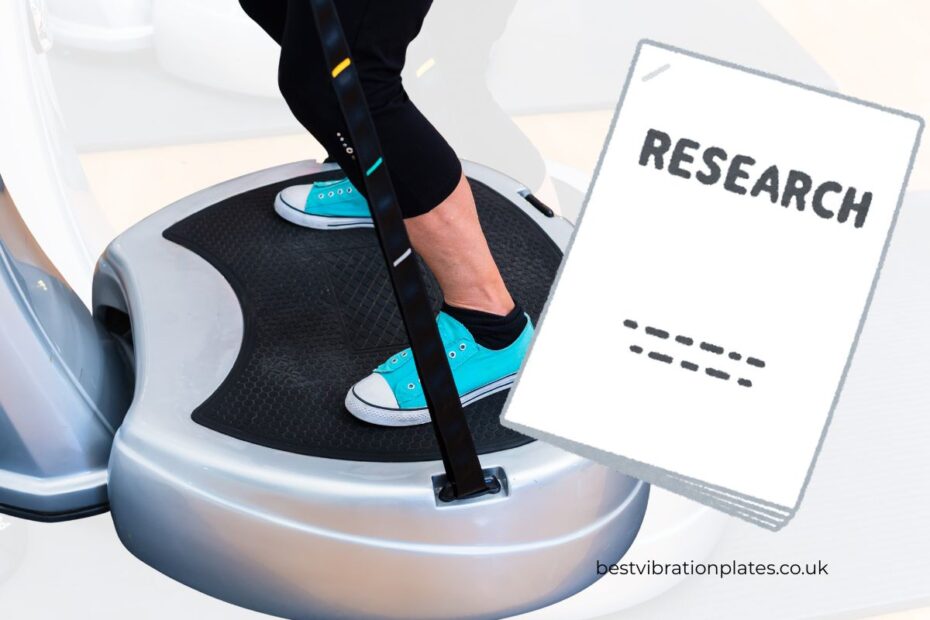Vibration Plate Research and Studies: A Comprehensive Analysis of Evidence-Based Benefits (2025)
Whole body vibration (WBV) platforms, commonly known as vibration plates, have seen growing adoption in medical, rehabilitation, and fitness settings. Yet, the question remains—how solid is the evidence behind their benefits?
This article presents a detailed analysis of the current state of vibration plate research studies, including clinical trials, peer-reviewed papers, and systematic reviews on outcomes such as bone density, muscle strength, balance, and circulation.
We also explore UK-specific contributions, future directions, and how to critically evaluate WBV studies before drawing conclusions.
Research Methodology Overview
WBV research primarily uses three forms of clinical investigation:
- Randomised Controlled Trials (RCTs): the gold standard in assessing effectiveness
- Meta-analyses and Systematic Reviews: aggregating multiple studies for statistical power
- Longitudinal cohort studies: measuring changes over extended timeframes
Study designs vary depending on target outcomes—musculoskeletal, cardiovascular, or neuromotor. Most trials use either vertical (linear) or pivotal (oscillating) platforms, with amplitude and frequency settings clearly documented. Duration ranges from 4 weeks to 12 months, with sessions typically held 2–4 times weekly.
Major Studies by Health Condition
Osteoporosis
WBV’s impact on bone mineral density (BMD) is one of the most researched areas, especially in postmenopausal women and elderly men.
| Study | Population | Duration | Key Outcome | Link |
|---|---|---|---|---|
| Gusi et al. (2006) | Postmenopausal women | 24 weeks | ↑ BMD in femur | PubMed |
| Rubin et al. (2004) | Young women | 12 months | Improved trabecular bone | PubMed |
| Lau et al. (2011) | Chinese elderly | 6 months | ↑ Spine BMD | PubMed |
Balance in the Elderly

WBV has shown strong potential for fall prevention and neuromotor improvements in vibration plates for seniors over 65.
- Bruyère et al. (2005) showed significant improvement in Tinetti balance scores after 6 months of WBV therapy (PubMed).
- Bogaerts et al. (2007) reported better postural control in frail older adults following 24 weeks of vibration training.
Athletic Performance
Short bursts of vibration training have been explored in enhancing vertical jump, sprint speed, and neuromuscular efficiency.
- Torvinen et al. (2002) demonstrated increased jump height in young athletes after just 4 weeks of WBV (PubMed).
- Rittweger et al. (2003) found acute gains in peak power output in male soccer players.
Weight Loss and Fat Reduction
While not a direct calorie-burning modality, WBV may assist in reducing visceral fat and improving metabolic markers.
- Van Nes et al. (2006) showed that WBV combined with a calorie-restricted diet produced more fat loss than diet alone.
- Vissers et al. (2010) conducted an 18-month trial indicating sustained abdominal fat loss in obese adults using WBV (PubMed).
Circulation
Studies have measured improvements in peripheral circulation and arterial stiffness metrics.
- Lohman et al. (2007) observed enhanced peripheral blood flow after 10-minute WBV sessions.
- Kerschan-Schindl et al. (2001) found acute increases in skin blood perfusion post-exposure (PubMed).
Study Quality Analysis
While many results are promising, critical scrutiny reveals inconsistencies. Only a minority of WBV trials are double-blinded due to the nature of physical interventions. Sample sizes vary dramatically, from n=12 pilot studies to n=180 large trials.
High-quality studies report:
- Clear intervention protocols (frequency, amplitude, duration)
- Well-defined control groups
- Objective outcome measures (e.g., DEXA scans, force plates)
Unfortunately, publication bias and selective reporting remain concerns.
Conflicting Research Explained
Some reviews have questioned WBV’s clinical relevance. A 2018 Cochrane review (PubMed) concluded that while WBV is safe, its benefits on bone and function are “modest and inconsistent.” These findings stem largely from heterogeneity in equipment, inconsistent program adherence, and varied health baselines across subjects.
Rather than invalidating WBV, such findings highlight the importance of protocol standardisation and targeted application.
Research Limitations Acknowledged
Despite promising findings, current clinical research on whole body vibration (WBV) therapy faces several limitations across most domains:
- Lack of long-term follow-up, making it difficult to assess sustained benefits or risks over time.
- Insufficient data on optimal frequency and amplitude combinations, particularly across different populations and use cases.
- Underrepresentation of high-risk or comorbid individuals, such as those with multiple chronic conditions, limiting generalisability.
- Challenges in blinding participants and clinicians, which increases the potential for placebo effects and performance bias in trial outcomes.
These limitations highlight the need for more robust, large-scale, and methodologically rigorous studies—especially in real-world UK clinical settings.
Future Research Directions
As of 2024, emerging trends in vibration therapy research point toward more personalised and integrated approaches. Key areas of focus include:
- Personalised WBV protocols tailored through genetic, biomechanical, and neuromuscular profiling to optimise outcomes for individuals.
- Integration with digital health tools, such as wearables and app-based biofeedback, enabling real-time adjustments and remote monitoring.
- Longitudinal studies investigating the role of WBV in managing chronic conditions like type 2 diabetes, multiple sclerosis (MS), and osteoarthritis.
- Large-scale UK-based clinical trials, potentially supported by the NHS, are expected within the next 2–3 years to establish standardised protocols for use in community rehabilitation and elder care.
Let me know if you’d like citations, links to current UK-based studies, or to convert this into a visual summary for your site.
How to Evaluate Vibration Studies
When reviewing new vibration plate research studies, look for the following markers of scientific credibility:
- Publication in peer-reviewed journals (e.g., JAMA, Osteoporosis Int.)
- Large sample sizes and multicentre designs
- Clinical endpoints over surrogate markers (e.g., falls vs. balance scores)
- Effect size and confidence intervals clearly reported
Anecdotal claims or marketing materials should never substitute for formal evidence.
UK-Specific Research Contributions
The UK has played a pivotal role in whole body vibration research UK. Institutions such as the University of Nottingham and King’s College London have led studies on musculoskeletal rehab, Parkinson’s, and stroke recovery.
NICE (National Institute for Health and Care Excellence) currently acknowledges WBV as an adjunct to conventional therapy for osteoporosis and frailty management in certain NHS settings.
Ongoing UK-led studies (2024–2026) are exploring WBV integration in community fall-prevention programs and post-operative physiotherapy.
Conclusion
Evidence Is Building, But Not Final
The scientific literature on vibration plates has evolved significantly in the past 20 years. While not a miracle cure, evidence supports its effectiveness for enhancing balance, strength, and bone integrity—especially in targeted populations, particularly when paired with a well-structured vibration plate workout program.
Further refinement of protocols, consistent vibration plate maintenance, and broader adoption in UK clinical settings will clarify WBV’s long-term role in preventive and rehabilitative medicine.
